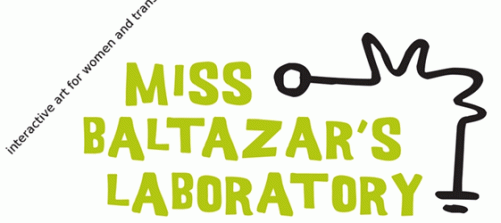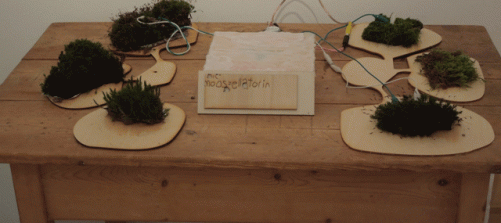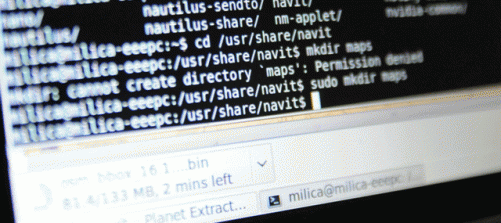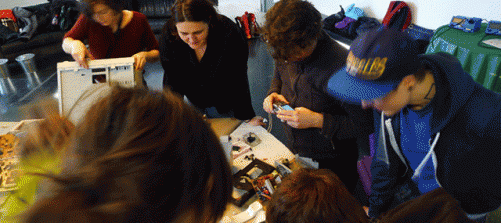Female Makers
Introduction
There has been a shift in technology. A shift from the habit of purely consuming technology as a commodity, such as a device, gadget or phone application, towards the trend of wanting to understand, take apart, play with and make technology by yourself. “Do-It-Yourself” (DIY) has become an essential topic in art, design and education. It has brought about new formats of labs that host people working in a hands-on and self-motivated way (Soler, 2008) (* 20 ). The shift from consuming to making things is understood as the core dynamic of the DIY movement. Some groups within this movement aim to generate an alternative production circle, a kind of economy alternative to the mainstream economic system. These groups try to distinguish themselves clearly from makers within the creative industries and other “operators of neo-liberal democracy” (Goriunova, 2008)
(* 20 ). The shift from consuming to making things is understood as the core dynamic of the DIY movement. Some groups within this movement aim to generate an alternative production circle, a kind of economy alternative to the mainstream economic system. These groups try to distinguish themselves clearly from makers within the creative industries and other “operators of neo-liberal democracy” (Goriunova, 2008) (* 9 ). They perceive the opportunity to “do things yourself” as freedom. To them “Freedom also has a dimension of collectivity, collective experience, as it is linked into an understanding of a human being as a social and public being.” (Goriunova 2008)
(* 9 ). They perceive the opportunity to “do things yourself” as freedom. To them “Freedom also has a dimension of collectivity, collective experience, as it is linked into an understanding of a human being as a social and public being.” (Goriunova 2008) (* 9 ) Differently oriented groups, although located on different sides of the political spectrum, are all agents in an emerging field called Open Culture. It includes the creation of new online platforms to collect, distribute, network, archive artifacts produced with DIY tools. “The current change, in one sentence, is this; most of the barriers to group action have collapsed, and without those barriers, we are free to explore new ways of gathering together and getting things done. (Shirky 2008: 22)
(* 9 ) Differently oriented groups, although located on different sides of the political spectrum, are all agents in an emerging field called Open Culture. It includes the creation of new online platforms to collect, distribute, network, archive artifacts produced with DIY tools. “The current change, in one sentence, is this; most of the barriers to group action have collapsed, and without those barriers, we are free to explore new ways of gathering together and getting things done. (Shirky 2008: 22) (* 19 ). The reader can get an impression of which kind of projects are produced and shared if one visits the web platform “thingiverse” [www.thingiverse.com]. This dynamic website hosted by Maker Bot offers users to add to and download from a database of projects related to DIY 3D print. Or you could explore the website processing.org, that collects projects realized with the DIY graphic environment Processing for creating images, animations, and interactions. These self-made pieces of software and artifacts are licensed as “creative commons” (CC). This licence allows users to re-use, adapt, basically change the existing materials on every level, without having to pay the author or ask for permission as the default “all rights reserved” would suggest. The user might need to give credit to the author and e.g. label it as running under “creative commons”, making it into a “some rights reserved” license. However, if a work is labeled as CC (creative commons license) the public receives permission to access it. This means that enthusiastic makers worldwide are free to mix and use materials published under CC for their purposes. Fabrics, old toys, electronic elements, code and even integrated circuits turn into potential things to tinker with. It might be the sensual feeling of soldering, the reward of being able to construct something with your own hands or the individual self expression achieved with the DIY-spirit that draws so many people into this movement. Yet the practice of using random materials or integrated circuits for self-made projects has reached a turning point. Companies have started to take advantage of DIY’s inherent drive. The publisher O’Reilly has presented more than five books on “Making Things” in Europe only in the last three years (Make: Electronics 2010, Making Things Move 2011, Making Things Talk 2012, Making Things Wearable 2012). For companies and entrepreneurs DIY smells like big business. Another critical point in the movement is the fact that being a “maker” has become synonymous for tinkering in DIY manner with electronics and tech-related materials. Becoming a “Maker” and being a “Maker” sounds like something open to everybody, but it actually comes with quite a few requirements. Although the web provides users with instructions and tutorials on how to make things on countless online platforms, the actual making of things demands awareness and a set of skills, something that is usually not mentioned by the experts providing support. It needs trust in ones own potentials and access to tools and machines. The phrase “Do-It-Yourself” has recently transformed into “Do-It-Together”. This is not because the collaborative aspect in tinkering is held in such high priority in the movement, but rather that the term “Do-It-Together” originates in the necessity of working in groups in order to reach the desired results. As soon as cutting-edge technology is involved, sharing tools, equipment and experiences is essential for a successful outcome. Moreover, the ability to formulate a tech-related question in a comprehensive way as well as in the lingua franca, English, is increasingly important. Only this way a person to who you are only connected via internet will be able to help you out. When you are stuck with a problem, being affiliated to one of their communities is unavoidable. In his paper “On free software art, design, communities and committees” Dave Griffiths claims:
(* 19 ). The reader can get an impression of which kind of projects are produced and shared if one visits the web platform “thingiverse” [www.thingiverse.com]. This dynamic website hosted by Maker Bot offers users to add to and download from a database of projects related to DIY 3D print. Or you could explore the website processing.org, that collects projects realized with the DIY graphic environment Processing for creating images, animations, and interactions. These self-made pieces of software and artifacts are licensed as “creative commons” (CC). This licence allows users to re-use, adapt, basically change the existing materials on every level, without having to pay the author or ask for permission as the default “all rights reserved” would suggest. The user might need to give credit to the author and e.g. label it as running under “creative commons”, making it into a “some rights reserved” license. However, if a work is labeled as CC (creative commons license) the public receives permission to access it. This means that enthusiastic makers worldwide are free to mix and use materials published under CC for their purposes. Fabrics, old toys, electronic elements, code and even integrated circuits turn into potential things to tinker with. It might be the sensual feeling of soldering, the reward of being able to construct something with your own hands or the individual self expression achieved with the DIY-spirit that draws so many people into this movement. Yet the practice of using random materials or integrated circuits for self-made projects has reached a turning point. Companies have started to take advantage of DIY’s inherent drive. The publisher O’Reilly has presented more than five books on “Making Things” in Europe only in the last three years (Make: Electronics 2010, Making Things Move 2011, Making Things Talk 2012, Making Things Wearable 2012). For companies and entrepreneurs DIY smells like big business. Another critical point in the movement is the fact that being a “maker” has become synonymous for tinkering in DIY manner with electronics and tech-related materials. Becoming a “Maker” and being a “Maker” sounds like something open to everybody, but it actually comes with quite a few requirements. Although the web provides users with instructions and tutorials on how to make things on countless online platforms, the actual making of things demands awareness and a set of skills, something that is usually not mentioned by the experts providing support. It needs trust in ones own potentials and access to tools and machines. The phrase “Do-It-Yourself” has recently transformed into “Do-It-Together”. This is not because the collaborative aspect in tinkering is held in such high priority in the movement, but rather that the term “Do-It-Together” originates in the necessity of working in groups in order to reach the desired results. As soon as cutting-edge technology is involved, sharing tools, equipment and experiences is essential for a successful outcome. Moreover, the ability to formulate a tech-related question in a comprehensive way as well as in the lingua franca, English, is increasingly important. Only this way a person to who you are only connected via internet will be able to help you out. When you are stuck with a problem, being affiliated to one of their communities is unavoidable. In his paper “On free software art, design, communities and committees” Dave Griffiths claims:
Software with a good community surrounding it is more useful than software which is engineered well, but lacks a community. Engineering alone is not enough to get most people’s attention or continued interest, and doesn’t guarantee people investing time learning and using it. It’s a mistake to separate the executable product from it`s community when discussing software. The community dictates the future of software.
The same counts for communities evolving around free hardware, such as the Arduino Microcontroller board or Open Culture practices as “Crafting”, a form of activism pushed forward by groups like the critical crafting circle (Gaugele, Kuni, 2011) (* 8 ). The new context of DIY tinkering in combination with a strong feeling of community and belonging to a platform allowed new group identities to emerge. Groups for mutual support, but as well for a mutual social experience. 3D print, Pure Data, V4, Raspberry Pi, SuperCollider are just a few tools that attract and connect a powerful network of users and developers. Many of these supporter groups articulated the need for a physical space to meet as real people, not as users only. A place that offers the chance of failure while in a safe space and a physical environment for experiments while members are passionately trying something new for the first time. Regular meetings and festivals were established to enable real world encounters and foster collective exploration. (For example the Piksel Festival in Bergen, that was born out of the collaboration of an artist and a programmer, Gisle Froysland and Carlo Prelz (Oreggia, 2008
(* 8 ). The new context of DIY tinkering in combination with a strong feeling of community and belonging to a platform allowed new group identities to emerge. Groups for mutual support, but as well for a mutual social experience. 3D print, Pure Data, V4, Raspberry Pi, SuperCollider are just a few tools that attract and connect a powerful network of users and developers. Many of these supporter groups articulated the need for a physical space to meet as real people, not as users only. A place that offers the chance of failure while in a safe space and a physical environment for experiments while members are passionately trying something new for the first time. Regular meetings and festivals were established to enable real world encounters and foster collective exploration. (For example the Piksel Festival in Bergen, that was born out of the collaboration of an artist and a programmer, Gisle Froysland and Carlo Prelz (Oreggia, 2008 (* 15 ))).
(* 15 ))).
In this article I want to focus on female makers in this quite peculiar DIY movement. Although they feel related to the maker community described above, female makers are still a minority within the movement. To illustrate how this group of people is working, I want to focus on a feminist Hackerspace that I am part of myself: Miss Baltazar’s Laboratory.
Feminist Hackerspaces
A hackerspace is a specific type of maker lab, dedicated to hacking, which is understood as the use of technology in a different way than intended by its developer. For example, to use your ashtray as a flowerpot is kind of hacking an ashtray. The feminist hackerspace I am member of, was founded in Vienna in 2009 by a group of female makers in a male dominated hackerspace. The group called itself Miss Baltazar’s Laboratory (MBL). It later became a self-managed autonomous lab in a different location than the original hackerspace in which it started. MBL focuses on giving participants access to new technologies through workshops. All workshops are organized by women and trans for women and trans. While being part of the developing process, I made observations in other international feminist tech groups: MzTek (London) and Genderchangers (Rotterdam). Both are inviting environments that can supply members with the tools required to tinker, hack and make things. A network that allows you to fail, but encourages you to try again with even more persistence. Not intimidated by gender scripts, participants can explore new concepts and techniques. In this text I want to explore why this development came about and raise the question of how a lab’s culture can grow more inclusive.
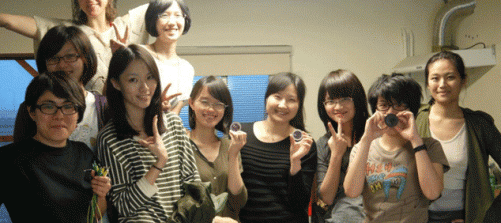
Miss Baltazar’s Laboratory Workshop at a hackerspace at Treasure Hill Artist Village, Tapai, Taiwan 2012
Hackerspaces and Open Source
The maker community is strongly affiliated with the Open Source Community (FLOSS+Art 2008). Also female makers often use Open Source Software to realize their projects. The advantages are manifold. First of all: accessibility online, then of course the open license that allows users to download and change the given code or material in the process of production. Finally most agents in the maker community want to point to the absurd relation between need and capital in the cooperative world. Through the example of Open Source Software they hope to demonstrate how easy it could be to explore different economic systems. Inspired by algorithmic production that creates endless replications of graphic objects through code, members of the maker community invented a 3D printer that can, for a low price, produce identical objects from digital 3D models. People are envisioning to create spare parts to fix broken machines, print out items they need or do not want to purchase. This project is a collaborative effort, well documented on websites as e.g. thingiverse.com mentioned above. This quite idealistic Open Source Hardware project has lead to a similar buzz in the community as e.g. to the ambitious project of the Ubuntu operating system, which today is seen as a successful threat to the Microsoft monopoly. Some speak of a paradigm change. Yet many projects spinning off the maker community, and this counts for the 3D printer as well, end in commercial applications, far off the spirit of the Open Source movement of the earlier days.
Some agents decided to re-invent and merge different fields of production within the same local physical space, then hackerspaces and Open Labs came into existence. They basically serve as working and production spaces and offer second living rooms for the agile community. Within this environment everything required for the product-circle is available, the original Open Source spirit is worshiped. The hackerspace is a small factory: from scratching the first idea, developing a concept and making a machine to realize the product, up to the distribution of not only the product, but the plans and instructions for the machine as well – be it an online application or a digital tool –, much is documented and published. While the products are still the expected end-results, the main attention is spent on the machine that is meant to create the desired output or product. This flip of intention (to be more interested in inventing tools of production rather than generating the product itself) can be interpreted as a trend towards makers wanting to keep control over all sections of the production-circle. Usually the way each section of the production circle is being built will be open and made accessible to others. The aim is to support each other in the development of independent off-scene ideas. Hence the makers explore ways of sharing their experience through online tools and digital media. Speaking of my own experiences in these environments, I must confess that I believe that what we learn changes us . The newly acquired skill is integrated in the self. For example a new habit or an identity narration telling me “I’m someone who can do this”, “This is what I can do”. The process of being part of entire sections within the production circle has got the potential of de-constructing long-held determinisms. Most hackerspaces are run by participants who feel close to the technology scene and IT sector. What distinguishes the Open Source Community from profit-orientated associations is their focus on social aspects like e.g. as a group aiming for equality. Yet, the community is not separated from mainstream culture and deeply interwoven with old power structures. Participants in Open Labs and hackerspaces struggle hard to get awareness and work on the dynamics that grant equal value to persons in their own community. Emerging hierarchies and power structures need to be evaluated and de-constructed again and again (Galloway 2004) (* 7 ). Often the Open Space Community shares the opinion that personal commitment is an individual decision rather than a consequence of working/living conditions outside a certain space. Therefore, participants who spend more time in the lab are seen as legitimately more influential. However, time and resources someone can invest into a shared space are dependent on conditions outside the lab. Free time is a precious resource mostly enabled through a stable income. A stable income mostly depends on education and position. But it also strongly depends on gender. The Gender Pay Gap in Germany was 23% in the year 2010 (Destatis, 2013)
(* 7 ). Often the Open Space Community shares the opinion that personal commitment is an individual decision rather than a consequence of working/living conditions outside a certain space. Therefore, participants who spend more time in the lab are seen as legitimately more influential. However, time and resources someone can invest into a shared space are dependent on conditions outside the lab. Free time is a precious resource mostly enabled through a stable income. A stable income mostly depends on education and position. But it also strongly depends on gender. The Gender Pay Gap in Germany was 23% in the year 2010 (Destatis, 2013) (* 5 ). Due to lower income, female makers tend to sacrifice less time and budget on Open Labs or into Open Source projects. Thus, feeling comfortable in a space is widely perceived as a question of personal taste or sympathy rather than a question of dominance. A group of men who spends a lot of time in an Open Lab can mark territory by gestures and male habitus, resulting in reduced comfort and diversity in a lab. If such problems get individualized rather than fought against as a communal issue that mutually affects all participants, the lab is not inviting to others. This leads to a form of bias, but most of all to a gender gap. In the hackerspaces I was researching, only one half to five percent of all members were females.
(* 5 ). Due to lower income, female makers tend to sacrifice less time and budget on Open Labs or into Open Source projects. Thus, feeling comfortable in a space is widely perceived as a question of personal taste or sympathy rather than a question of dominance. A group of men who spends a lot of time in an Open Lab can mark territory by gestures and male habitus, resulting in reduced comfort and diversity in a lab. If such problems get individualized rather than fought against as a communal issue that mutually affects all participants, the lab is not inviting to others. This leads to a form of bias, but most of all to a gender gap. In the hackerspaces I was researching, only one half to five percent of all members were females.
Miss Baltazar’s Laboratory
This is why in Vienna some women and trans joined as MBL. The aim was to foster feminist approaches towards technologies, technologies taking the female perspective as central point to embark from. On MBL’s agenda was fighting harassment in labs and to demystify technology, take apart hardware and invent new techniques, create new role-models and encourage females to become tech savvy. It started as an experiment in 2009 and it started growing quickly, once it had an autonomous space in Vienna. When the new space grew too small also, the collective migrated to a 100 square meter space.
In this feminist hackerspace reading groups, Open Lab Sessions, exhibitions, workshops on open hardware and open software, lectures and discussions take place. Around 170 women and trans are part of the mailing list. The organizer’s core team consists of six artists. Personal authorship is exchanged with collaborative, multiple authorships. One of the projects that were developed collaboratively at MBL is called Mosszillator: This instrument was built from moss and oscillators. Touching and pressing the moss created different resistances that controlled the sound. A tree served as an amplifier to the sound signal via transducer. Many different people added their ideas to this project, brought along new electronic elements that would fit and finally showed the finished project in an exhibition.
Other access
Participants of our space had searched access in other places before they joined MBL: e.g. corporate companies that offered them equipment and education. Yet these companies were taking credit for whatever they developed inside the company’s premises. Other participants had attended expensive elite universities to seek resources to realize their projects, but were confronted with the dilemma of sacrificing one’s new gained freedom to the back-payment of enormous tuition fees.
Others had tried to learn from pioneers and more established feminist groups like the genderchangers, subRosa or the old boys network. The women who created these important structures are by now happy to leave the legacy of endless fighting and struggling in younger hands. Many have disappeared.
Some rare personalities, the ones who are equipped with a sharp tongue and indifference towards harassment, stayed for years in hackerspaces and used these high-tech-rich environments to learn about the things they were interested in.
But at some point all of the groups described above visit the feminist hackerspace and dream about access to networks, tools, skills, platforms without the drawbacks they have experienced in other technology related places. This attitude differs strongly from cyberfeminist`s perception of the „Internet as a means of freedom from social constructs like gender and sex difference“ (Haraway, 1991) (* 11 ). The feminist hackerspace approach towards experiences of exclusion is more pragmatic. The belief in the possibility of a spontaneous or temporary autonomous space that is free from gender difference has faded (Hakim, 1991)
(* 11 ). The feminist hackerspace approach towards experiences of exclusion is more pragmatic. The belief in the possibility of a spontaneous or temporary autonomous space that is free from gender difference has faded (Hakim, 1991) (* 10 ) and given place to the insight that the reflections upon the conditions of exclusion can`t be avoided.
(* 10 ) and given place to the insight that the reflections upon the conditions of exclusion can`t be avoided.
Clones
In 1977 Rosabeth Kanter published her theory on the clone-effect (or “homosoziale Reproduktion” how she called it in German). Her theory suggests that people find it easier to enter social environments if they know that people with similar interests/attitudes are already part of this environment. She calls these people “clones”. The feminist hackerspace supports to think radical ideas and allows for radical ideas to be articulated. The comfort of sharing future plans with like-minded people is empowering. I want to call the participants who feel like they belong to the feminist hackerspace “clones”. They recognize each other as similar to themselves – sometimes for obvious reasons, sometimes the similarities remain obscure. It might for example be a shared experience of discrimination or a mutual passion for technology. Many of the clones coming together in feminist hackerspaces also want to invent new forms of collaboration and collaborative work. The high amount of mutual identification, the risk of sharing ideas and resources brings along insecurity, hand in hand with the fear to loose ground and get exploited. Trust in the new structure and the agents working in it has to be created in countless meetings and conversations. It needs to be part of the feminist hackerspace’s program. This worked really well in a workshop that was lead by Manuela Zechner who is a researcher and cultural worker focused on care, collective processes and social movements. She is based in Vienna and finalizes her PhD at the British Queen Mary University, UK. She conceptualized the workshop around the issue of „care“. It is based on the Theater of the Oppressed where Manuela asked participants to imitate a working process by playing different roles in a small performance. Soon the group started to crack out in laughter since the individual roles were so precisely portrayed in the improvised performance.
Another very positive turn was taking place during a workshop in Offenbach after a MBL’s “noise toy”-workshop. At a male dominated music festival a group of female workshop participants took over the stage. They performed with their self-made instruments in front of a speechless male audience. Their performance started an intense discussion on access to electronic music festivals.
The hardware crash course by Helga Hofstätter ended with cheering female hackers, taking apart hard drives to turn them into art pieces. Hofstätter is singer and activist in Vienna and her hardware crash courses can be experienced at MBL.
Sudden changes of scripts become possible, if groups with radical structures are manifesting new rules. Mostly out of the blue, participants who were shy and feeling insecure, start to be fearless and original in their behavior. Undisputed roles can start to melt when clone-groups take action.This might not be recognizable as a form of resistance, but it in fact can lead to awareness about the potential of feminist makers. This way gender scripts are slowly loosing their dominance and new horizons open up.
At the same time the shift in a group of clones can spin off new concepts and demands. A re-calibration of the usual scripts allows participants to take new risks and create newly narrated identities.
Stefanie Wuschitz ( 2013): Female Makers. In: p/art/icipate – Kultur aktiv gestalten # 02 , https://www.p-art-icipate.net/female-makers/


